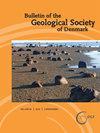Triassic lithostratigraphy of the Wandel Sea Basin, North Greenland
IF 1
4区 地球科学
Q2 Earth and Planetary Sciences
引用次数: 11
Abstract
The Wandel Sea Basin in eastern North Greenland forms the northern continuation of the offshore Danmarkshavn Basin and the conjugate margin to the western Barents Shelf south of Spitsbergen. The Triassic succession of eastern North Greenland, up to 700 m thick, spans the Induan (Dienerian) – Norian. The Triassic sediments rest unconformably on Upper Carboniferous and Upper Permian sediments, and are unconformably overlain by Upper Jurassic – Lower Cretaceous deposits. Based on recent fieldwork in the Wandel Sea Basin, five new and revised Triassic formations are described and included in the Trolle Land Group (revised). The Lower Triassic (Induan) Parish Bjerg Formation (revised) consists of marine sandstones, fluvial conglomerates and sandstones, and muddy flood-plain deposits. It is conformably overlain by Lower Triassic (Dienerian – lower Spathian) offshore mudstones with minor sand-dominated intervals of the Ugleungernes Dal Formation (new). The upper Spathian to Ladinian Dunken Formation (revised) is represented mainly by marine sandstones. A marked erosional unconformity characterises the base of the overlying Upper Triassic (Carnian – Norian) Storekløft Formation (new) composed of marginal marine to marine, massive sandstones and conglomerates as well as cross-bedded and biomottled marine sandstones and minor mudstone units. The Isrand Formation (mainly Middle Triassic) consists of laminated mudstones with minor thin sandstone units that were deposited in slope and basin floor settings in the eastern deeper part of the Wandel Sea Basin in Kronprins Christian Land. The Triassic succession of the Wandel Sea Basin represents a well-constrained shallow shelf to deep shelf / basin floor transect and thus forms an excellent outcrop analogue to the time-equivalent intervals in the western Barents Sea basins and the Danmarkshavn Basin offshore North-East Greenland.格陵兰北部万德尔海盆地三叠纪岩石地层学
北格陵兰岛东部的Wandel海盆地形成了海上Danmarkshavn盆地的北部延伸,以及斯匹次卑尔根岛以南的西部巴伦支陆架的共轭边缘。北格陵兰岛东部的三叠纪演替,厚达700米,跨越了Induan (Dienerian) - Norian。三叠纪沉积物不整合位于上石炭统和上二叠统沉积物之上,并被上侏罗统-下白垩统沉积物不整合覆盖。根据最近在Wandel海盆地的野外工作,描述了5个新的和修订的三叠纪地层,并将其纳入了特罗勒陆群(修订)。下三叠统(Induan) Parish Bjerg组(订正)由海相砂岩、河流砾岩和砂岩以及泥质洪泛平原沉积组成。它被下三叠统(二叠统-下斯巴达统)近海泥岩整合覆盖,并具有较小的以砂为主的Ugleungernes Dal组(新)层段。上Spathian—Ladinian Dunken组(订正)以海相砂岩为主。上三叠统(卡尼期-诺里期)Storekløft组(新)的基底具有明显的侵蚀不整合特征,该组由边缘海相到海相块状砂岩和砾岩以及交错层状和生物侵蚀的海相砂岩和小型泥岩单元组成。岛组(主要为中三叠统)由层状泥岩和少量薄砂岩单元组成,沉积于Kronprins Christian Land Wandel海盆地东部较深的斜坡和盆地底环境中。Wandel海盆地的三叠纪演替代表了一个约束良好的浅陆架到深陆架/盆地底样带,因此形成了一个与西巴伦支海盆地和格陵兰东北部近海Danmarkshavn盆地的时间等效间隔非常相似的露头。
本文章由计算机程序翻译,如有差异,请以英文原文为准。
求助全文
约1分钟内获得全文
求助全文
来源期刊

Bulletin of the Geological Society of Denmark
GEOSCIENCES, MULTIDISCIPLINARY-
CiteScore
2.80
自引率
16.70%
发文量
28
审稿时长
>12 weeks
期刊介绍:
The Bulletin publishes contributions of international interest in all fields of geological sciences on results of new work on material from Denmark, the Faroes and Greenland. Contributions based on other material may also be submitted to the Bulletin if the subject is of relevance for the geology of the area of primary interest.
 求助内容:
求助内容: 应助结果提醒方式:
应助结果提醒方式:


